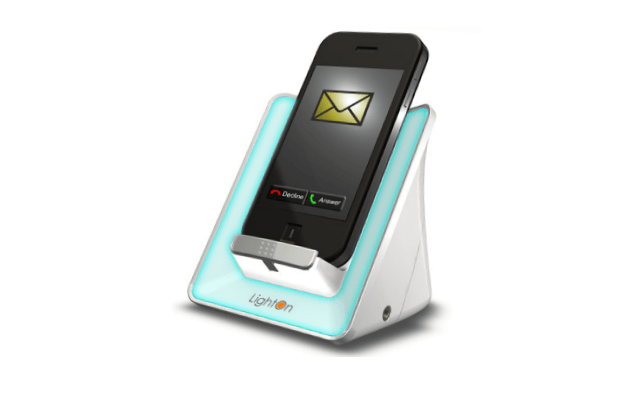For people suffering from hearing impairment or deafness, text messaging and video calls in sign language can be vital for day-to-day communication. However, very often they miss these calls and messages – simply because they do not hear the phone ring.
LightOn, the first commercial product by startup DreamZon, aims to solve this problem by turning audio notifications into visual ones.
Related Stories:
- Researchers: Sound Can Activate ‘Sight’ For The Blind
- Will The Blind See? Israeli Startup Might Be The First To Make It Happen
LightOn, which was commercially launched in early 2011, is a smartphone dock that is based on vibration detection. When a new text message or video call comes in, LightOn detects the vibrations and alerts the user with flashing lights. According to the company, all users have to do is to make sure their phone is on vibrate mode.
“LightOn is already a popular mobile phone signaler. It works with all existing mobile phones,” says Alon Schwartzman, Co-Founder and VP Sales and Marketing. He adds: “We’ve developed a special algorithm which detects all mobile phones’ vibration and translates them into a visual light notification.”
[youtube]http://www.youtube.com/watch?v=n_evZ906ELI[/youtube]
LightOn is also designed for hands-free video chat, even more helpful for people communicating in sign language, and works for alarms and other reminders as well.
Integrating with alert systems
Sign up for our free weekly newsletter
SubscribeThe product is designed to integrate with external alerting systems on the market. For example, users can purchase a bed shaker to place under their pillows at night to assure they are woken up if a message or call is received. The bed shaker is manufactured by DreamZon’s German business partner Humatechnik.
LightOn is battery-operated, making it portable and travel-friendly. Schwartzman tells NoCamels that LightOn is the first product of its kind that can connect to “various market-leading alerting systems.” If the customer is in a separate room while their phone rings, LightOn can connect to a wireless alerting system, signaling a vibrating pager or a blinking flash receiver placed elsewhere in the house. The first generation of LightOn is already commercially available in over 20 countries.
Treating a common impairment
There are other similar products on the market, such as one, designed by Serene Innovations. Schwartzman says LightOn is different in that it signals light from the front and back of the device and does not need a power source, as it is placed in a dock.
According to the American National Institute on Deafness and Other Communication Disorders (NIDCD) 17 percent of the adult population in the United States report some degree of hearing loss. In Israel, 15 percent of the population over the age of 20 has some form of hearing impairment and according to the Israeli Central Bureau of Statistics, 3.5 percent of the population has severe hearing problems or cannot hear at all.
DreamZon was founded by Eli Padan and Alon Schwartzman in the fall of 2010. “DreamZon’s vision is to develop technology products that make our customers day-to-day routine easier, striving to eliminate any frustrating difficulties that they face today,” Schwartzman explains. “Our goal is to become the leading global Assistive Listening Devices (ALD) company, developing solutions that have never been seen before.”
DreamZon has five employees and is based in Herzliya, Israel.
Related posts

Israeli Medical Technologies That Could Change The World

Harnessing Our Own Bodies For Side Effect-Free Weight Loss

Missing Protein Could Unlock Treatment For Aggressive Lung Cancer




Facebook comments